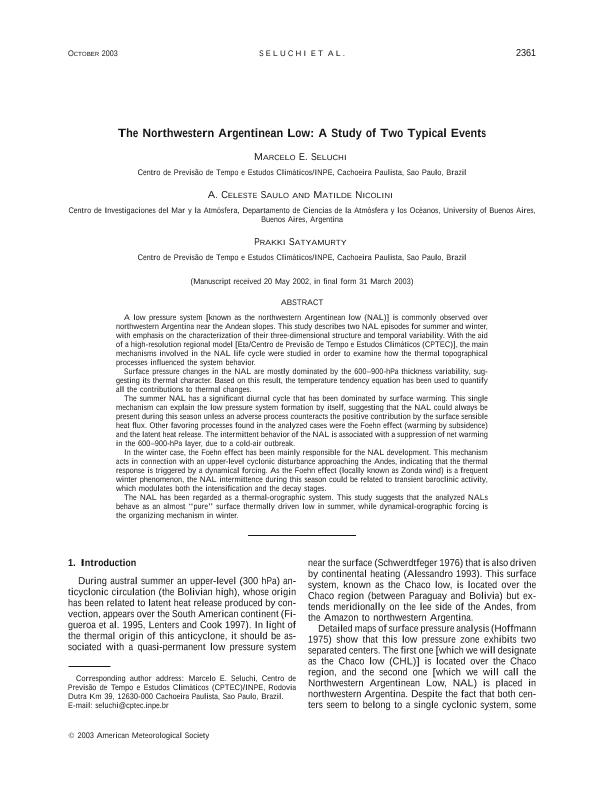Mostrar el registro sencillo del ítem
dc.contributor.author
Seluchi, Marcelo Enrique

dc.contributor.author
Saulo, Andrea Celeste

dc.contributor.author
Nicolini, Matilde

dc.contributor.author
Satyamurty, Prakki
dc.date.available
2022-12-27T12:11:13Z
dc.date.issued
2003-10
dc.identifier.citation
Seluchi, Marcelo Enrique; Saulo, Andrea Celeste; Nicolini, Matilde; Satyamurty, Prakki; The Northwestern Argentinean Low: A Study of Two Typical Events; Amer Meteorological Soc; Monthly Weather Review; 131; 10; 10-2003; 2361-2378
dc.identifier.issn
0027-0644
dc.identifier.uri
http://hdl.handle.net/11336/182458
dc.description.abstract
A low pressure system [known as the northwestern Argentinean low (NAL)] is commonly observed over northwestern Argentina near the Andean slopes. This study describes two NAL episodes for summer and winter, with emphasis on the characterization of their three-dimensional structure and temporal variability. With the aid of a high-resolution regional model [Eta/Centro de Previsa˜o de Tempo e Estudos Clima´ticos (CPTEC)], the main mechanisms involved in the NAL life cycle were studied in order to examine how the thermal topographical processes influenced the system behavior. Surface pressure changes in the NAL are mostly dominated by the 600–900-hPa thickness variability, suggesting its thermal character. Based on this result, the temperature tendency equation has been used to quantify all the contributions to thermal changes. The summer NAL has a significant diurnal cycle that has been dominated by surface warming. This single mechanism can explain the low pressure system formation by itself, suggesting that the NAL could always be present during this season unless an adverse process counteracts the positive contribution by the surface sensible heat flux. Other favoring processes found in the analyzed cases were the Foehn effect (warming by subsidence) and the latent heat release. The intermittent behavior of the NAL is associated with a suppression of net warming in the 600–900-hPa layer, due to a cold-air outbreak. In the winter case, the Foehn effect has been mainly responsible for the NAL development. This mechanism acts in connection with an upper-level cyclonic disturbance approaching the Andes, indicating that the thermal response is triggered by a dynamical forcing. As the Foehn effect (locally known as Zonda wind) is a frequent winter phenomenon, the NAL intermittence during this season could be related to transient baroclinic activity, which modulates both the intensification and the decay stages. The NAL has been regarded as a thermal-orographic system. This study suggests that the analyzed NALs behave as an almost ‘‘pure’’ surface thermally driven low in summer, while dynamical-orographic forcing is the organizing mechanism in winter.
dc.format
application/pdf
dc.language.iso
eng
dc.publisher
Amer Meteorological Soc

dc.rights
info:eu-repo/semantics/openAccess
dc.rights.uri
https://creativecommons.org/licenses/by-nc-sa/2.5/ar/
dc.subject
ARGENTINA
dc.subject
NORTHWESTERN
dc.subject
NAL
dc.subject.classification
Meteorología y Ciencias Atmosféricas

dc.subject.classification
Ciencias de la Tierra y relacionadas con el Medio Ambiente

dc.subject.classification
CIENCIAS NATURALES Y EXACTAS

dc.title
The Northwestern Argentinean Low: A Study of Two Typical Events
dc.type
info:eu-repo/semantics/article
dc.type
info:ar-repo/semantics/artículo
dc.type
info:eu-repo/semantics/publishedVersion
dc.date.updated
2021-12-03T20:50:00Z
dc.journal.volume
131
dc.journal.number
10
dc.journal.pagination
2361-2378
dc.journal.pais
Estados Unidos

dc.journal.ciudad
Boston
dc.description.fil
Fil: Seluchi, Marcelo Enrique. Consejo Nacional de Investigaciones Científicas y Técnicas. Oficina de Coordinación Administrativa Ciudad Universitaria. Centro de Investigaciones del Mar y la Atmósfera. Universidad de Buenos Aires. Facultad de Ciencias Exactas y Naturales. Centro de Investigaciones del Mar y la Atmósfera; Argentina. Centro de Previsao de Tempo e Estudos Climáticos. Instituto Nacional de Pesquisas Espaciais; Brasil
dc.description.fil
Fil: Saulo, Andrea Celeste. Consejo Nacional de Investigaciones Científicas y Técnicas. Oficina de Coordinación Administrativa Ciudad Universitaria. Centro de Investigaciones del Mar y la Atmósfera. Universidad de Buenos Aires. Facultad de Ciencias Exactas y Naturales. Centro de Investigaciones del Mar y la Atmósfera; Argentina
dc.description.fil
Fil: Nicolini, Matilde. Consejo Nacional de Investigaciones Científicas y Técnicas. Oficina de Coordinación Administrativa Ciudad Universitaria. Centro de Investigaciones del Mar y la Atmósfera. Universidad de Buenos Aires. Facultad de Ciencias Exactas y Naturales. Centro de Investigaciones del Mar y la Atmósfera; Argentina
dc.description.fil
Fil: Satyamurty, Prakki. Centro de Previsao de Tempo e Estudos Climáticos. Instituto Nacional de Pesquisas Espaciais; Brasil
dc.journal.title
Monthly Weather Review

dc.relation.alternativeid
info:eu-repo/semantics/altIdentifier/url/https://journals.ametsoc.org/view/journals/mwre/131/10/1520-0493_2003_131_2361_tnalas_2.0.co_2.xml
dc.relation.alternativeid
info:eu-repo/semantics/altIdentifier/doi/http://dx.doi.org/10.1175/1520-0493(2003)131%3C2361:TNALAS%3E2.0.CO;2
Archivos asociados
